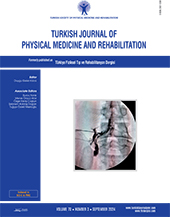Effectiveness of static, dynamic and combined dry needling techniques in the management of myofascial pain syndrome: A three-group study
2 Department of Physical Medicine and Rehabilitation, Üsküdar State Hospital, Istanbul, Türkiye DOI : 10.5606/tftrd.2024.14310 Objectives: This study aims to evaluate and compare the therapeutic effectiveness of static dry needling (S-DN), dynamic dry needling (D-DN), and a combined technique (CT) for managing myofascial pain syndrome (MPS).
Patients and methods: Between January 1, 2023 and April 15, 2023, a total of 38 patients (9 males, 29 females; mean age: 40.5±12.7 years; range, 22 to 63 years) with MPS who experienced neck pain for less than six months and had at least one painful myofascial trigger point in the trapezius, rhomboids, or levator scapula muscle were included in the study. The patients were divided into three groups: D-DN, S-DN, and CT. Measurements included the Visual Analog Scale (VAS), range of motion (ROM), Neck Disability Index (NDI), and the European Quality of Life 5 Dimensions 3 Level Version (EQ5D3L). All measurements were made at baseline (T0), after the first treatment session (T1), after the final session (T2), and one-month post-treatment (T3).
Results: The group treated with S-DN showed less significant improvement in ROM scores compared to other treatment methods. Both the D-DN and S-DN groups showed decreased VAS scores at rest and during motion across all time points, compared to the CT group. The NDI scores decreased in all groups, while the EQ5D3L scores exhibited no variations between groups or across any time point irrespective of the treatment method employed.
Conclusion: Our study results suggest that all three methods are effective in treating MPS, with D-DN potentially being the preferred method over S-DN and CT due to its time efficiency.
Keywords : Dynamic dry needling, myofascial pain syndrome, static dry needling

















